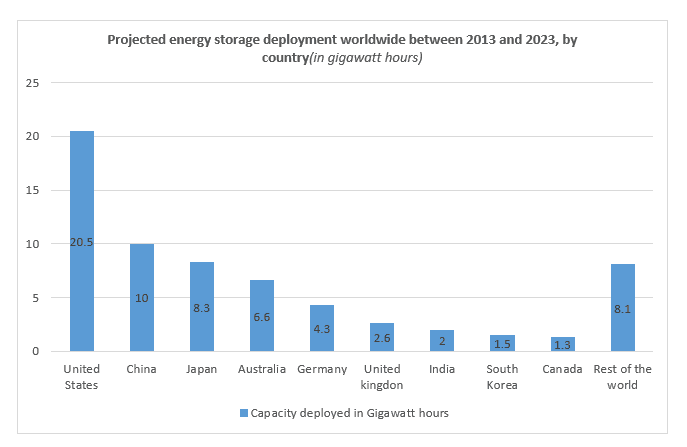Wzmacnianie Odporności Energetycznej: Wzrost Systemów Rozproszonego Magazynowania Energii
TheSystem Rozproszonego Magazynowania Energii (DES)jest zasadniczo pakietowym rozwiązaniem, które magazynuje energię do wykorzystania w przyszłości. Dwa główne komponenty systemu to akumulatory ładowane prądem stałym i dwukierunkowy falownik.
Kluczowe cechy DES
- Redukcja szczytowego zapotrzebowania
- Regulacja napięcia
- Przesuwanie obciążenia
- Integracja odnawialnych źródeł energii
- Zasilanie awaryjne
Najważniejsze trendy do obserwowania
- Pojemność magazynowania energii w akumulatorach rośnie szybko
Chińska firma BYD Co. buduje fabrykę akumulatorów do pojazdów w przyszłym roku w ramach wysiłków producenta samochodów elektrycznych w celu zwiększenia wydajności i wsparcia wzrostu zysków.
- Technologia Wyboru dla ESS na bazie energii słonecznej
W przypadku paneli słonecznych, magazyn energii zasilany akumulatorami litowo-jonowymi jest kluczową technologią wyboru w danym momencie. Wzrost zapotrzebowania na pojazdy elektryczne w znacznym stopniu przyczynił się do udoskonalenia technologii litowo-jonowych w ostatnich czasach.
- ESaaS to Kluczowy Model Usługi
ESaaS to przede wszystkim połączenie zaawansowanego systemu magazynowania energii, systemu zarządzania energią i umowy serwisowej, która może przynieść wartość dla firmy poprzez dostarczanie niezawodnego zasilania w sposób bardziej ekonomiczny.
- Uśredniony Koszt Magazynowania (LCOS) to nowo powstająca metryka
Uśredniony Koszt Magazynowania (LCOS) mierzy efektywność ESS w sieci, która obsługuje 80-90% energii odnawialnej po dodaniu magazynowania.
- Rosną możliwości finansowania magazynów akumulatorów na podstawie projektu
Ulepszenia w modelu biznesowym i metrykach przychodów/kosztów zaawansowanych systemów magazynowania, dają odnowione skupienie na finansowaniu projektów dla transakcji ESS.
- System magazynowania energii w akumulatorach wykorzystuje sztuczną inteligencję w celu obniżenia rachunków za energię i świadczenia usług dla sieci energetycznych.
Sztuczna inteligencja odgrywa również kluczową rolę w systemach rozproszonego magazynowania energii. Zapewnia różne sposoby i metody obniżania rachunków za energię i ulepszania usług.

Przyszłośćsystemów rozproszonego magazynowania energii
Rządy i firmy zobowiązują się do osiągnięcia neutralności węglowej w nadchodzących latach; dlatego będziemy potrzebować coraz więcej energii wiatrowej i słonecznej, ale będziemy również musieli magazynować tę energię, aby można było ją wykorzystać w razie potrzeby.
W nadchodzących dziesięcioleciach będziemy generować więcej energii elektrycznej z energii wiatrowej i bezemisyjnych źródeł energii słonecznej i będziemy magazynować tę energię w pobliżu źródła, w pobliżu społeczności i branż, które jej używają, i wszędzie pomiędzy. Czysta energia zasili branże, domy, samochody, samoloty itp., co oznacza, że będziemy potrzebować większej zdolności magazynowania i produkcji energii odnawialnej.
Wykorzystanie rozproszonych systemów energetycznych wzrośnie o 40% do 2030 roku
Zgodnie z Electricity Network Transformation Roadmap (ENTR), ponad 40% odbiorców energii będzie korzystać z DER do 2027 r., a do 2050 r. liczba ta wzrośnie do ponad 60%.
Raport stwierdza również, że rozproszone systemy energetyczne przyniosą znaczne korzyści ekonomiczne, społeczne i środowiskowe, w tym niższe koszty bilansowania sieci, zmniejszoną emisję gazów cieplarnianych i przystępne rozszerzenie sieci do niepołączonych społeczności. Ponieważ coraz więcej właścicieli budynków myśli o swoich przyszłych celach energetycznych i unowocześnianiu swoich budynków, DES zapewnia sposób na obniżenie kosztów operacyjnych i zapewnienie długoterminowego bezpieczeństwa energetycznego
Kluczowe korzyści DES

Wniosek
Magazynowanie energii jest potencjalnym substytutem lub uzupełnieniem prawie każdego aspektu systemu elektroenergetycznego, w tym wytwarzania, przesyłu i elastyczności popytu. Przemysł i działalność komercyjna przyjmują systemy dystrybucji magazynowania energii. Pomaga to w dekarbonizacji naszej infrastruktury energetycznej i walce ze zmianami klimatycznymi. DES zapewnia sposób na obniżenie kosztów operacyjnych i zapewnienie długoterminowego bezpieczeństwa energetycznego.
Autor: Muzakkir Ali
